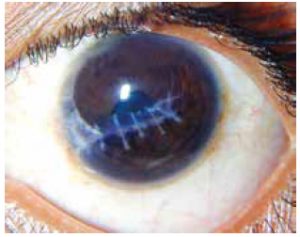What determine pupil size?
 Park et al conducted a study to assess the correlation between pupil size, measured by Humphrey static perimetry, and various affecting factors in patients with glaucoma. In total, 825 eyes of 415 patients, pupil size was measured with Humphrey static perimetry. Correlations were made with presence of glaucoma, age, logMAR best corrected visual acuity (BCVA), retinal nerve fiber layer (RNFL) thickness, spherical equivalent, intraocular pressure, axial length, central corneal thickness, white-to-white, and the kappa angle. They found that pupil size was significantly smaller in glaucoma patients than in glaucoma suspects (p < 0.001) or the normal group (p < 0.001). It decreased significantly as age (p < 0.001) and central cornea thickness (p = 0.007) increased, and increased significantly as logMAR BCVA (p = 0.02) became worse and spherical equivalent (p = 0.007) and RNFL thickness (p = 0.042) increased. In patients older than 50 years, pupil size was significantly larger in eyes with a history of cataract surgery. They concluded that factors affecting pupil size can be used in a preoperative evaluation when considering cataract surgery or laser refractive surgery.
Park et al conducted a study to assess the correlation between pupil size, measured by Humphrey static perimetry, and various affecting factors in patients with glaucoma. In total, 825 eyes of 415 patients, pupil size was measured with Humphrey static perimetry. Correlations were made with presence of glaucoma, age, logMAR best corrected visual acuity (BCVA), retinal nerve fiber layer (RNFL) thickness, spherical equivalent, intraocular pressure, axial length, central corneal thickness, white-to-white, and the kappa angle. They found that pupil size was significantly smaller in glaucoma patients than in glaucoma suspects (p < 0.001) or the normal group (p < 0.001). It decreased significantly as age (p < 0.001) and central cornea thickness (p = 0.007) increased, and increased significantly as logMAR BCVA (p = 0.02) became worse and spherical equivalent (p = 0.007) and RNFL thickness (p = 0.042) increased. In patients older than 50 years, pupil size was significantly larger in eyes with a history of cataract surgery. They concluded that factors affecting pupil size can be used in a preoperative evaluation when considering cataract surgery or laser refractive surgery.
Read More:
Park JW, Kang BH, Kwon JW, Cho KJ. Analysis of various factors affecting pupil size in patients with glaucoma. BMC Ophthalmol. 2017 Sep 16;17(1):168.
Does a tablet computer actually induce visual fatigue?
An interesting study evaluates a question everyone has been raising all along. What visual discomfort is induced by tablet computers? Fiftynine volunteers (age, 38.16 ± 10.23 years; male : female = 19 : 40) were exposed to tablet computer screen stimuli (iPad Air, Apple Inc.) for 1 hour. They were made to either watch a movie or play a game. Visual fatigue and discomfort were assessed using an asthenopia questionnaire, tear film break-up time, and total ocular wavefront aberration before and after viewing smart mobile devices. The study found that there was a significantly increased mean total asthenopia score predominantly in the form of tired eyes, sore/aching eyes, irritated eyes, watery eyes, and hot/burning eyes score. Tear film break-up time significantly decreased from 5.09 ± 1.52 seconds to 4.63 ± 1.34 seconds (p = 0.003). However, total ocular wavefront aberration was unchanged. The authors concluded that visual fatigue and discomfort were significantly induced by viewing smart mobile devices, even though the devices were equipped with stateof – the-art display technology
Read More:
Kim DJ, Lim CY, Gu N, Park CY. Visual Fatigue Induced by Viewing a Tablet Computer with a High-resolution Display. Korean J Ophthalmol. 2017;31:e45